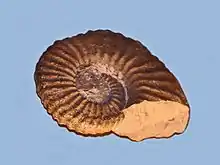Hemihoplites
Hemihoplites is an extinct genus of ammonoid cephalopods belonging to the family Hemihoplitidae. These fast-moving nektonic carnivores [1] lived in the Cretaceous period, from Hauterivian age to Barremian age.[2]
| Hemihoplites | |
|---|---|
 | |
| Fossil shells of Hemihoplites soulieri from Alpes-de-Haute-Provence, on display at Galerie de paléontologie et d'anatomie comparée in Paris | |
| Scientific classification | |
| Kingdom: | |
| Phylum: | |
| Class: | |
| Subclass: | |
| Order: | |
| Family: | |
| Genus: | Hemihoplites Spath, 1924 |
Species
- Hemihoplites feraudianus (d'Orbigny, 1841)
- Hemihoplites mexicanus Imlay, 1940
- Hemihoplites ploszkiewiczi Riccardi and Aguirre Urreta, 1989
- Hemihoplites soulieri (Matheron, 1878)
- Hemihoplites varicostatus Riccardi and Aguirre Urreta, 1989
Distribution
Fossils of species within this genus have been found in the Cretaceous rocks of southeastern France, Mexico, Slovakia, South Africa and Trinidad and Tobago.[1]
This article is issued from Wikipedia. The text is licensed under Creative Commons - Attribution - Sharealike. Additional terms may apply for the media files.
